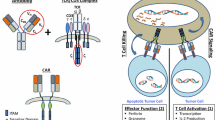Abstract
The immunological responsiveness of the T-cell immunodificient NC nude mice tumor models was reconstructed by thymic transplantation of the semidominance NC mice. After immune reconstruction (IR) the tumor continued to grow until 2 to 3 weeks, then the volume of the tumor reduced gradually and disappeared at the 9th week. In both H901 and SW1116 solid tumor nodules was found by light microscopic study (IM), after IR, tumor cells gradually replaced by lymphocytes and fibroblasts, shrinked till only isolated cell groups, then totally disappeared. The whole processes like that the tumor cells were nibbled. It was found that the main tumor cell death related with a specific feature of apoptosis, which had typical dense chromatin distributed along the inner surface of the nuclear membrane by transmission electron microscopic study (TEM). The IR model could be useful for further mechanical research of immune system.
Similar content being viewed by others
References
Kerr JFR, Wyllie AH, Currie AR. Apoptosis: a basic biological phenomenon with wide-ranging implications in tissue kinetics. Br J Cancer 1972; 26:239.
Searle J, Lawson TA, Abbott PJ, et al. An electron-microscope study of the mode of cell death induced by cancer chemotherapeutic agents in populations of proliferating normal and neoplastic cells. J Path 1975; 116;129.
Schwartz LM, Osborne BA. Programmed cell death, apoptosis and killer genes. Immuno Today 1993; 14:582.
Vaux DL, Haecker G, Strasser A. An evolutionary perspective on apoptosis. Cell 1994; 76:777.
Thompson CB. Apoptosis in the pathogenesis and treatment of disease. Science 1995; 267:1456.
Matsubara K, Kubota M, Heike Y, et al. Induction of apoptosis in childhood acute leukemia by chemotherapeutic agents: failure to detect evidence of apoptosis 4in vivo 5. Eur J Haematol 1994; 52:47.
Okamoto-kubo S, Nishio K, Heike S, et al. Apoptosis induced by etoposide in small-cell lung cancer cell lines. Cancer Chemother Pharmacal 1994; 33:385.
Amenta JS, Sargus MJ, Baccino FM, et al. Cell death induced in L-cell by treatment with thymidine: staging of the process and relationship to apoptosis.In Vitro Cell Dev Biol 1993; 29A:855.
Vallbo C, Bergenheim T, Bergh A, et al. DNA fragmentation induced by the antimitotic drug estramustine in malignant rat glioma but not in normal brain-suggesting an apoptotic cell death. Br J Cancer 1995; 71:717.
Minato N. Natural killer cells: characteristics and their role in anti-tumor resistance. Gann Monograph on Cancer Res 1988; 34:99.
Author information
Authors and Affiliations
Rights and permissions
About this article
Cite this article
Da, Y., Hua, Y., Shu, Z. et al. T-lymphocyte mediated tumor cell destructionin vivo associating with a specific feature of apoptosis. Chinese Journal of Cancer Research 8, 9–13 (1996). https://doi.org/10.1007/BF02674959
Accepted:
Issue Date:
DOI: https://doi.org/10.1007/BF02674959




